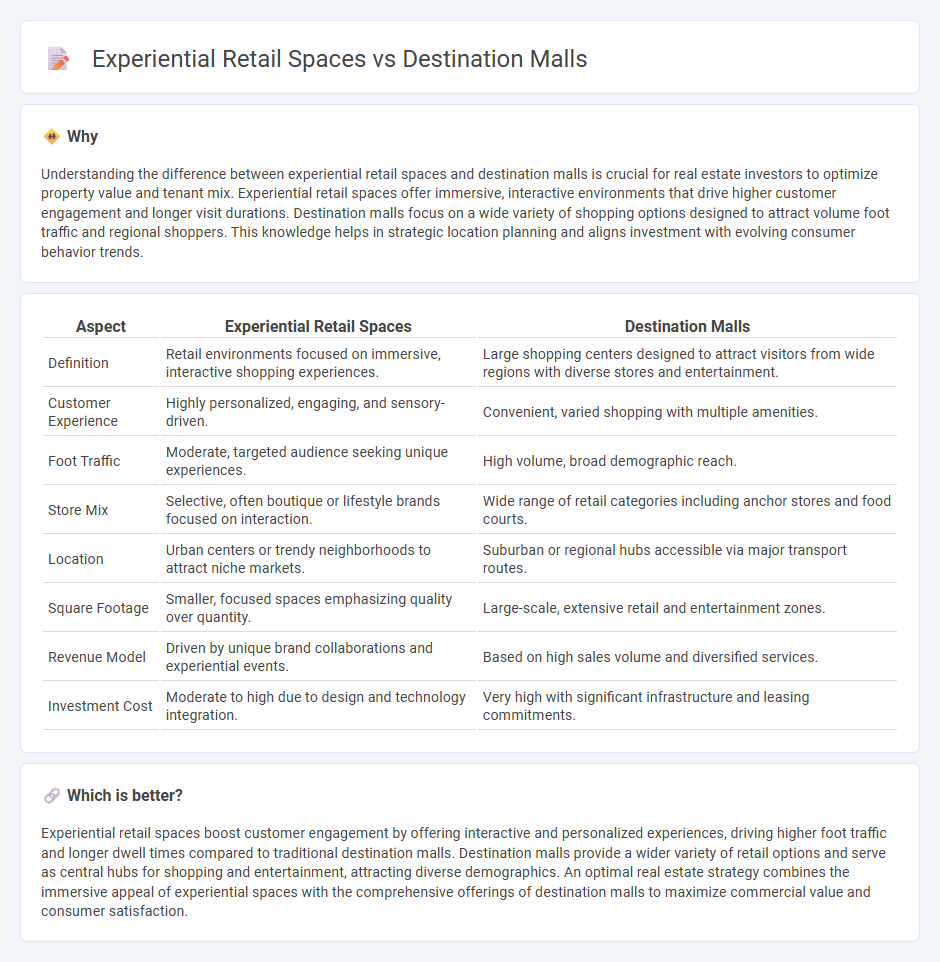
Experiential retail spaces focus on immersive, interactive shopping experiences that engage customers beyond traditional purchases, often incorporating technology, events, and personalized services. Destination malls serve as large-scale shopping hubs designed to attract visitors from wide geographic areas through a mix of retail, dining, and entertainment options. Explore the evolving dynamics between these two retail formats to understand their impact on consumer behavior and real estate development.
Why it is important
Understanding the difference between experiential retail spaces and destination malls is crucial for real estate investors to optimize property value and tenant mix. Experiential retail spaces offer immersive, interactive environments that drive higher customer engagement and longer visit durations. Destination malls focus on a wide variety of shopping options designed to attract volume foot traffic and regional shoppers. This knowledge helps in strategic location planning and aligns investment with evolving consumer behavior trends.
Comparison Table
| Aspect | Experiential Retail Spaces | Destination Malls |
|---|---|---|
| Definition | Retail environments focused on immersive, interactive shopping experiences. | Large shopping centers designed to attract visitors from wide regions with diverse stores and entertainment. |
| Customer Experience | Highly personalized, engaging, and sensory-driven. | Convenient, varied shopping with multiple amenities. |
| Foot Traffic | Moderate, targeted audience seeking unique experiences. | High volume, broad demographic reach. |
| Store Mix | Selective, often boutique or lifestyle brands focused on interaction. | Wide range of retail categories including anchor stores and food courts. |
| Location | Urban centers or trendy neighborhoods to attract niche markets. | Suburban or regional hubs accessible via major transport routes. |
| Square Footage | Smaller, focused spaces emphasizing quality over quantity. | Large-scale, extensive retail and entertainment zones. |
| Revenue Model | Driven by unique brand collaborations and experiential events. | Based on high sales volume and diversified services. |
| Investment Cost | Moderate to high due to design and technology integration. | Very high with significant infrastructure and leasing commitments. |
Which is better?
Experiential retail spaces boost customer engagement by offering interactive and personalized experiences, driving higher foot traffic and longer dwell times compared to traditional destination malls. Destination malls provide a wider variety of retail options and serve as central hubs for shopping and entertainment, attracting diverse demographics. An optimal real estate strategy combines the immersive appeal of experiential spaces with the comprehensive offerings of destination malls to maximize commercial value and consumer satisfaction.
Connection
Experiential retail spaces enhance destination malls by offering immersive, interactive environments that attract foot traffic and increase dwell time. Destination malls integrate these engaging experiences with diverse retail and entertainment options to create shopping hubs that serve as both commercial and social centers. This synergy drives higher consumer engagement and boosts overall mall revenue through unique, memorable visits.
Key Terms
Anchor Tenants
Destination malls rely heavily on anchor tenants such as major department stores or international brands to drive foot traffic and enhance overall shopping experiences. Experiential retail spaces prioritize unique, interactive anchors like pop-up shops, entertainment zones, or immersive brand experiences to attract and retain customers. Discover how anchor tenant strategies shape the future of retail environments and customer engagement.
Mixed-Use Development
Mixed-use developments increasingly integrate destination malls and experiential retail spaces to maximize foot traffic and enhance consumer engagement through diverse offerings like dining, entertainment, and lifestyle services. Destination malls serve as anchor points with high brand visibility, while experiential retail spaces prioritize immersive, interactive experiences that foster longer visits and repeat patronage. Explore how these dynamic retail formats transform urban landscapes and drive economic growth in mixed-use developments.
Foot Traffic
Destination malls generate high foot traffic by offering a wide range of retail, dining, and entertainment options, creating a one-stop shopping experience that attracts diverse customer demographics. Experiential retail spaces prioritize immersive and interactive environments, boosting foot traffic by engaging customers through unique, memorable experiences that encourage longer visits and social sharing. Explore more to understand how these retail formats shape consumer behavior and drive foot traffic growth.
Source and External Links
10 Best Shopping Malls in Minneapolis - Features a list of the best shopping malls in Minneapolis, including the renowned Mall of America.
Mall of America: Huge Shopping and Entertainment - Offers insights into the vast shopping and entertainment options at the Mall of America, including over 520 stores and various attractions.
Mall of America - Details the Mall of America as the largest mall in the United States and a major shopping and entertainment destination.
 dowidth.com
dowidth.com